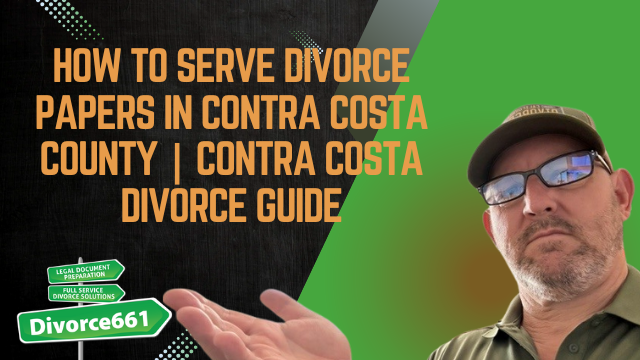How to Serve Divorce Papers in Contra Costa County | Contra Costa Divorce Guide
Hi, I’m Tim Blankenship from Divorce661. In my video I walk through the exact steps for serving divorce papers in Contra Costa County. Serving your spouse correctly is required in every divorce case — and if it’s done incorrectly, your case can be delayed or even dismissed. Below I cover what documents you must serve, who can serve them, how to file proof of service, and the easiest option for amicable situations.
Why proper service matters
Proper service gives the court proof that your spouse was notified of the divorce. Courts will not proceed without valid service. Mistakes at this stage can stall hearings, stop orders from going into effect, or create opportunities for your case to be challenged. Taking the time to serve correctly avoids unnecessary delays and expense.
What documents must be served
In Contra Costa County (and across California), you typically must serve:
- Summons
- Petition (or Petition for Dissolution)
- UCCJEA (UCCJEA declaration) — if you have minor children
The person who serves these documents will complete a Proof of Service of Summons form that is later filed with the court.
Who can serve the papers
State law is clear: you cannot serve the papers yourself. The server must be:
- At least 18 years old
- Not a party to the case
This means a friend, family member, or a professional process server can do it for you. The important part is the server must complete the Proof of Service form accurately, attesting to how and when service occurred.
How to serve—step by step
- File your petition with the court and obtain your case number and filed copies.
- Prepare the packet to be served: Summons, Petition, UCCJEA (if applicable), and any other required local forms.
- Arrange for a qualified server (someone over 18 who is not part of the case).
- The server personally hands the documents to your spouse (personal service) and completes the Proof of Service of Summons form.
- File the completed Proof of Service with the court to show service was completed.
Personal service details
Personal service means the server physically hands the documents to your spouse. If your spouse avoids service, process servers will attempt multiple times and may serve at work or other likely locations permitted by law. Each attempt and method must be documented on the Proof of Service.
The notice of acknowledgement and receipt—best for amicable cases
If your spouse is cooperative, you can avoid traditional personal service by using a Notice of Acknowledgment and Receipt. With that method, your spouse signs a form acknowledging receipt of the papers. Benefits:
- Faster — no waiting for personal service attempts
- Simpler and less adversarial
- Still satisfies court requirements when done correctly
Use this option when both parties can communicate civilly and there’s no safety concern.
Proof of Service — file it correctly
After service is completed, the person who performed the service must sign the Proof of Service form. You then file that proof with the court. The Proof of Service tells the court:
- When and how service occurred
- Who served the documents
- Where the documents were served
Filing the Proof of Service correctly is essential—without it the court may treat your case as unserved and take no further action.
Common mistakes to avoid
- Trying to serve the papers yourself — this is not allowed.
- Using an underage or interested party as the server.
- Failing to include the UCCJEA if you have children.
- Not filing the Proof of Service or filing an incorrectly completed form.
- Assuming informal hand-delivery without documentation satisfies the court.
Real client example
We had a Contra Costa client who was stuck because she wasn’t sure how to meet the court’s service requirements. She couldn’t get reliable confirmation that her spouse had been served. We explained the options, coordinated the service (or arranged acknowledgement where appropriate), and filed the Proof of Service. The case moved forward within days instead of weeks.
Practical tips and checklist
- Confirm which documents your local court requires before service.
- Choose a neutral server who is over 18 and not involved in the case.
- Consider the Notice of Acknowledgment if your spouse will cooperate.
- Keep copies of everything and make sure the Proof of Service is accurate and promptly filed.
- If you’re unsure, get help early so you don’t delay your case.
How Divorce661 can help
At Divorce661 we handle the entire service process for you: coordinating service, ensuring the correct documents are used, and filing the Proof of Service with the court. We offer flat-fee pricing and free consultations so you know the steps and costs up front.
“We’ll make sure every step is handled the right way so your case moves forward smoothly.”
Next steps
If you need help serving divorce papers in Contra Costa County and want to avoid mistakes, delays, or confusion, schedule a free consultation at Divorce661.com. We’ll guide you through the right method for your situation—personal service or the acknowledgement route—and handle the filings so your case can move forward without unnecessary hiccups.
Conclusion
Serving divorce papers correctly is one of the earliest and most important steps in a California divorce. Know what must be served, who can serve, and how to file proof. If you want help to ensure service is done right the first time, we’re here to help.

